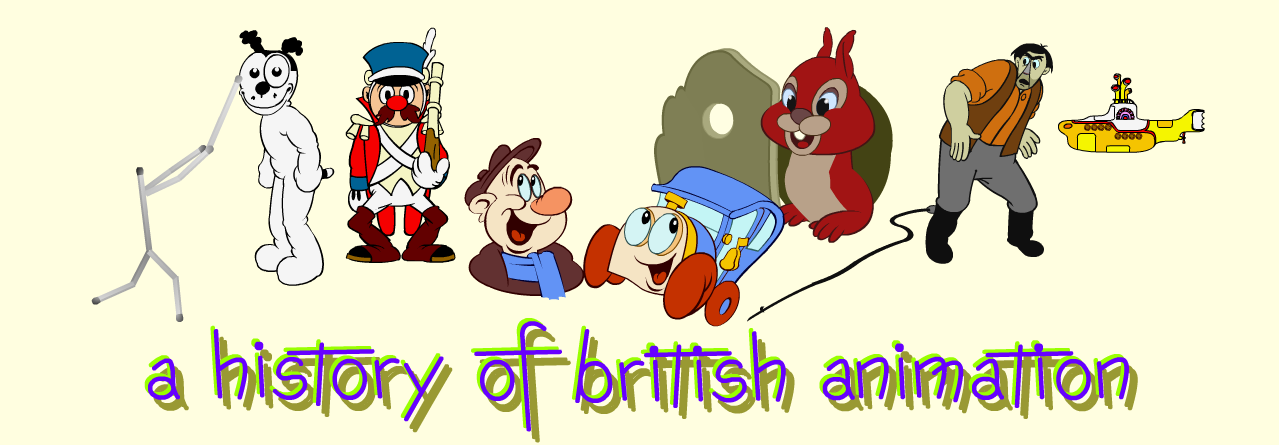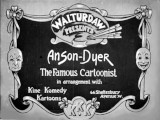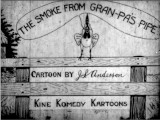

|
 | Frank Zeitlin(1886-1849) |  |
||
|
Frank Isadore Zeitlin was born in Aldgate, London on 21 December 1886, the fifth of six children born to the cigar importer Joseph Zeitlin and his wife Sara. In 1899 he was admitted to St Augustine's Boys' Secondary School in Kilburn, and the family subsequently moved to 4a Harvist Road, which would remain the family home for the next 15 years. Frank started work in the insurance business, but both his elder brothers had gone into theatrical management and it is possible that Frank moved into some sort of variety agency work. On the outbreak of war Frank enlisted in the Loyal North Lancashire Regiment. He was made a temporary 2nd Lieutenant, but relinquished his commission in November 1915 due to ill-health. Returning to civvy street he formed the animation studio Kine Komedy Kartoons in 1916, in partnership with Leslie Demainbray Sewell. It would seem that the intention from the start was to rival the American cartoons by collecting the best British animators under one roof. To this end they they approached Dudley Buxton and Anson Dyer, who were making alternate films in the John Bull's Animated Sketch Book series for the Cartoon Film Company. While they waited for Buxton and Dyer to complete their contract with the Cartoon Film Company, Kine Komedy Kartoons leased office space at 66 Shaftesbury Avenue and started production with a series of dramatic propaganda drawn by Ernest H Mills, portrait photographer, cartoonist and 'lightning artist' stage performer. With Buxton and Dyer joining in 1917 Kine Komedy Kartoons got a distribution deal with the Broadwest Film Company, who proceeded to promote the films in the trade magazines. Zeitlin was still living with his parents and siblings and about this time they moved from Harvist Road to 14 Ashworth Mansions, Elgin Avenue. This remained the family home, held by Frank's brother Alfred after the deaths of their parents, until 1931. Mills, Buxton and Dyer produced a regular output of animated films and became familiar names to cinema goers. The opening title card for Anson Dyer's Agitated Adverts (released by Walturdaw in early 1918) shows Dyer's name prominently featured above that of Kine Komedy Kartoons. This practice recognises the 'star' quality of the cartoonist in selling product, but may also be Zeitlin's way of compensating for an inability to pay his animators higher wages. It certainly explains why the release listings in the trade press often credit the distributor or the animator as producer, rather than KKK. The problem remained that Kine Komedy Kartoons' films were upto three times more expensive than the US imports, such as the very popular Mutt and Jeff series, which had already paid for themselves in the domestic market and could be offered abroad at lower rates. The American system of sequential drawings also had more vitality than the cut-out animation that the British animators were using, where flat, jointed figures were moved progressively frame by frame. Kine Komedy Kartoons was not making the profit it needed to survive. It would appear that Zeitlin's partner, Leslie Sewell, did not consider the business worth pursuing, and on 23 January 1919 the partnership was formally dissolved. Zeitlin, however, was determined to make a success of Kine Komedy Kartoons and tried attracting other cartoonists into the fold. A deal with the ambitious young designer Victor Hicks seems to have resulted in only one film. Hicks became enthusiastic about animation but left Kine Komedy Kartoons to make his own distribution deal with the Lionel Phillips Company. Zeitlin had better luck acquiring the rights to use the published cartoons of newspaper cartoonist Poy and the popular Zig Zags at the Zoo illustrations from the Strand Magazine by J A Shepherd. A deal was struck with distributor the Phillips Film Company for a series of twelve films for release in 1919: three Cheerio Chums cartoons from Dudley Buxton, featuring the exploits of ex-servicemen Jerry and Nobbler, three Uncle Remus cartoons from Anson Dyer, featuring Brer Rabbit; three films of Poy cartoons reproduced 'lightning artist' style; and three Zig Zags at the Zoo cartoons, to be animated by E H Mills. Zeitlin also persuaded American animator J S "Vet" Anderson, just demobbed from the British Army, to join the Shaftesbury Avenue studio to demonstrate the "American method" of animation using sequential drawings. Anson Dyer was not interested in changing his methods, but Dudley Buxton took an interest, as did Joe Noble, a title card designer working in the same building. Shepherd, dissatisfied with Mills' animation on the first of the Zig Zags, became more involved in the production process, and Zeitlin encouraged him to plan films with other print artists, including H E Bateman. On completing his three Uncle Remus films Anson Dyer quit to make animated cutout cartoons for Hepworth Picture Plays. Buxton started to make films useing sequential drawings and Shepherd was also keen to use it, but it was all too late. Zeitlin coulndn't raise enough money to keep going and had to admit defeat. Kine Komedy Kartoons seems to have closed its doors at the end of 1920. Zeitlin built on his experience in the film community to set up as a booking agent for actors, and by 1922 had a thriving business. In 1931, aged 44, he married 19-year-old Russian emigré and prospective film actress Marina Alexeieff. It is possible that this was just a marriage of convenience, to give her British citizenship. She subsequently went to Hollywood and married the screenwriter Rian James. Zeitlin continued representing stage and screen actors into the thirties, but in the 1939 Register he gives his occupation as impresario, suggesting he had moved into organising productions, a field where his brothers Alfred and Leon were active in the theatre. Frank Zeitlin died in Hampstead, in 1949, in his 63rd year. |
Filmography | ||||
| The Battle of Jutland | (Kine Komedy Kartoons, 1916) Producer | |||
| What London Saw at 2.18 a.m. on September 3rd, 1916 a.k.a. Supremacy | (Kine Komedy Kartoons, 1916) Producer | |||
| The Romance of David Lloyd-George | (Kine Komedy Kartoons, 1917) Producer | |||
| The Devil's Little Joke | (Kine Komedy Kartoons, 1917) Producer | |||
| The Entente Cordiale | (Kine Komedy Kartoons, 1917) Producer | |||
| Peter's Picture Poems | (Kine Komedy Kartoons, 1917) Producer | |||
| The Kaiser's Record | (Kine Komedy Kartoons, 1917) Producer | |||
| How to Run a Cinema | (Kine Komedy Kartoons, 1917) Producer | |||
| The Romance of President Wilson | (Kine Komedy Kartoons, 1917) Producer | |||
| Food for Reflection | (Kine Komedy Kartoons, 1917) Producer | |||
| Russia the Resolute | (Kine Komedy Kartoons, 1917) Producer | |||
| The Plot That Failed | (Kine Komedy Kartoons, 1917) Producer | |||
| Admiral Beatty—The Nelson Touch | (Kine Komedy Kartoons, 1917) Producer | |||
| Old King Coal | (Kine Komedy Kartoons, 1918) Producer | |||
| Ever Been Had? | (Kine Komedy Kartoons, 1918) Producer | |||
| Kaiser Bill—Showman | (Kine Komedy Kartoons, 1918) Producer | |||
| Agitated Adverts | (Kine Komedy Kartoons, 1918) Producer | |||
| The Office Boy's Dictionary | (Kine Komedy Kartoons, 1918) Producer | |||
| The British Through German Eyes | (Kine Komedy Kartoons, 1918) Producer | |||
| The Office Boy's Dictionary No.2 | (Kine Komedy Kartoons, 1918) Producer | |||
| More Agitated Adverts | (Kine Komedy Kartoons, 1918) Producer | |||
| Twice Nightly | (Kine Komedy Kartoons, 1918) Producer | |||
| The Raid on Zeebrugge | (Kine Komedy Kartoons, 1918) Producer | |||
| Blood and Iron (not confirmed) | (Kine Komedy Kartoons, 1918) Producer | |||
| Foch the Man | (Kine Komedy Kartoons, 1918) Producer | |||
| A Child's Dream of Peace | (Kine Komedy Kartoons, 1918) Producer | |||
| Well I'll Be Blowed!: Cheerio Chums No.1 | (Kine Komedy Kartoons, 1919) Producer | |||
| Uncle Remus No.1 | (Kine Komedy Kartoons, 1919) Producer | |||
| Zig-Zags at the Zoo No.1 | (Kine Komedy Kartoons, 1919) Producer | |||
| Poy Cartoon No.1 | (Kine Komedy Kartoons, 1919) Producer | |||
| Hot Stuff: Cheerio Chums No.2 | (Kine Komedy Kartoons, 1919) Producer | |||
| Zig-Zags at the Zoo No.2 | (Kine Komedy Kartoons, 1919) Producer | |||
| Uncle Remus No.2 | (Kine Komedy Kartoons, 1919) Producer | |||
| Poy Cartoon No.2 | (Kine Komedy Kartoons, 1919) Producer | |||
| Nobbler Flies the Pacific: Cheerio Chums No.3 | (Kine Komedy Kartoons, 1919) Producer | |||
| The Tiger, Clemenceau | (Kine Komedy Kartoons, 1919) Producer | |||
| The New Keeper's Dream: Zig-Zags at the Zoo No.3 | (Kine Komedy Kartoons, 1919) Producer | |||
| Uncle Remus No.3 | (Kine Komedy Kartoons, 1919) Producer | |||
| Poy Cartoon No.3 | (Kine Komedy Kartoons, 1919) Producer | |||
| In the Spring a Young Man's Fancy: "Bucky's Burlesques" No.1 | (Kine Komedy Kartoons, 1920) Producer | |||
| Clutching Eyebrows: "Bucky's Burlesques" No.2 | (Kine Komedy Kartoons, 1920) Producer | |||
| The Daring Deeds of Duckless Darebanks | (Kine Komedy Kartoons, 1920) Producer | |||
| Going Away: possibly Bucky's Burlesques No.3 | (Kine Komedy Kartoons, 1920) Producer | |||
| By the Sad (Sea?) Waves: Bucky's Burlesques No.4 | (Kine Komedy Kartoons, 1920) Producer | |||
| Running a Cinema: "Memoirs of Miffy" No.1 | (Kine Komedy Kartoons, 1920) Producer | |||
| A Fishy Business: "Memoirs of Miffy" No.2 | (Kine Komedy Kartoons, 1920) Producer | |||
| The Smoke from Gran-Pa's Pipe | (Kine Komedy Kartoons, 1920) Producer | |||
Links to Other Sites | ||||
Peter Hale
Last updated 2022
|